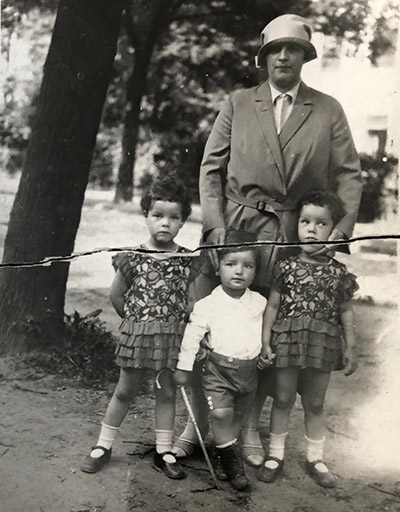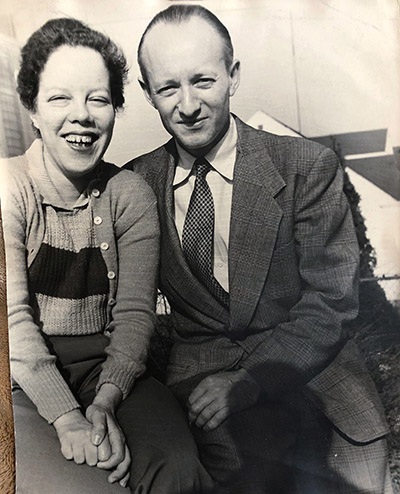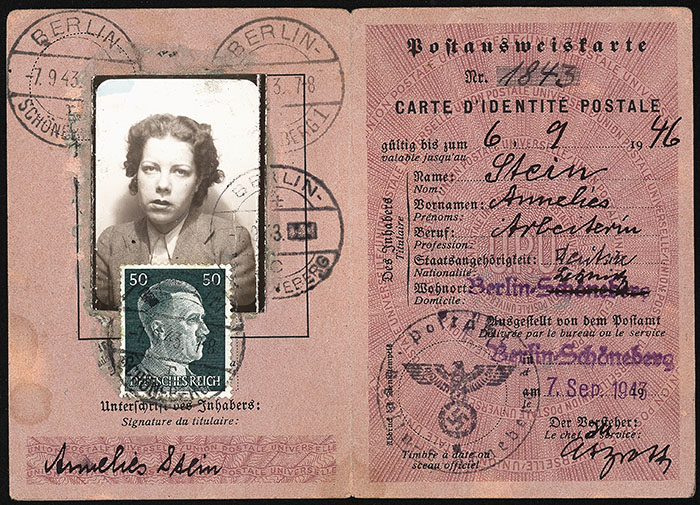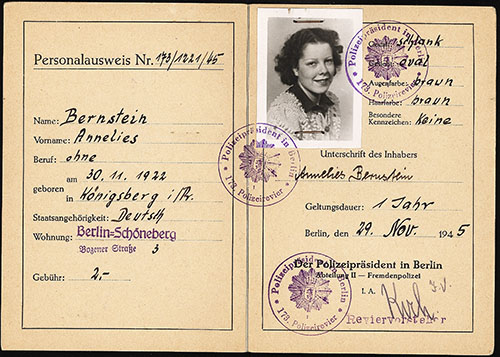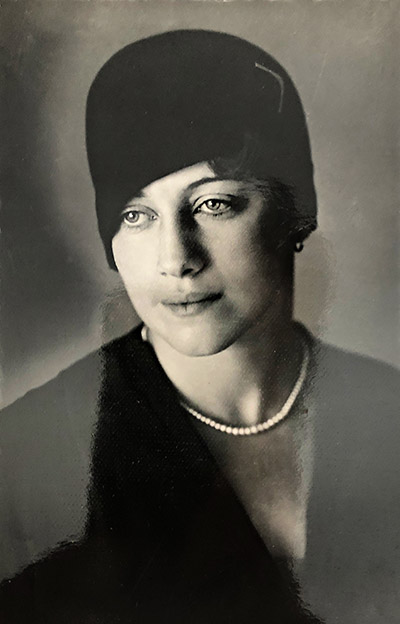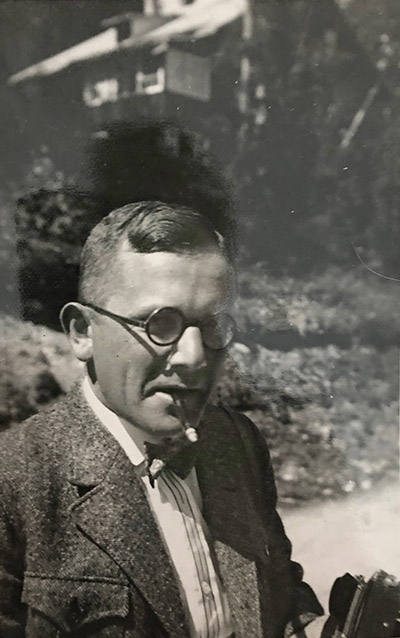By Dr. Samuel Kassow
When historians study Jewish resistance in the Holocaust, one topic that tends to get overlooked is escape and evasion. But, in fact, that is how a significant number of Jews fought for their lives after the Nazis began the Final Solution. One recent study of the Holocaust in Polish small towns and rural areas revealed that of the 1,250,000 Jews who lived in these places, as many as 150,000 tried to evade death by hunkering down in hideouts, fleeing into the forests, securing false documents, seeking help and shelter from Polish peasants, and devising other survival strategies. The odds were stacked against them, and most were informed on and murdered, often by people they trusted. Fewer than one in three lived to see the liberation, and those who did needed not just luck but also the help of trustworthy non-Jews. But their struggle to survive reminds us that, in the face of Nazi terror and humiliation, many Jews—far from being passive and cowed victims—summoned the will and the agency to fight for their lives.
As the remarkable story of Annelies Herz shows, Jews in Germany drew on that same determination and resourcefulness to survive. Especially in Berlin, many Jews became, in the slang of the time, “U-boats.” They lived under the radar, some with false papers, some in hiding, some constantly on the run, going from one place to another, staying just a few steps ahead of the police. Richard Lutjens’s important study, Submerged on the Surface, reveals that in Berlin alone, 6,500 Jews tried to go into hiding or live under false identities between 1941 and 1945. Of these, about 1,700 survived—Annelies Herz and her sister, Marianne, among them. Theirs is a story of luck, daring, brazenness, and hard-headed calculation.
Annelies Bernstein was born in the East Prussian city of Königsberg (now Kaliningrad, Russia) in 1922. She had two siblings: her twin sister, Marianne, and a younger brother, Benno. Their father was a respected banker. The Jewish community, small but economically secure, numbered about 3,500 when the Nazis came to power in 1933. Annelies’s early childhood was a happy one, and she had fond memories of summers spent at a family beach house on the nearby Baltic shore. But that happy home life was shattered when Annelies was 10 and her father, falsely accused of financial irregularities, took his own life. Meanwhile, even as a young girl, Annelies could sense that life in Königsberg was precarious; the Nazis were particularly popular in East Prussia, even before Hitler became chancellor in 1933.
In her important book, Between Dignity and Despair: Jewish Life in Nazi Germany, Marion Kaplan uses the term “social death” to describe the steadily deteriorating position of German Jewry after Hitler came to power. Ostracism by their non-Jewish neighbors began early. And then the vise tightened: the elimination of Jews from the civil service, expulsions from schools, the enactment of the Nuremberg Laws, and the expropriation of property. After Kristallnacht in November 1938, the legal assault accelerated in the form of special identification cards, the mandatory use of “Jewish names,” forced labor, restrictions on the use of public transport, forced residence in special “Jewish buildings,” and, in September 1941, the compulsory wearing of a Jewish star.
Deportations of Jews from the Reich “to the east” began in October 1941. By then, Annelies and Marianne were living in Berlin. Benno had been sent to live with relatives in Riga, Latvia, and later perished there. Their mother, who had stayed behind in Königsberg, was ordered to leave on an early transport. When the first deportations started, Jews still had little inkling about where they were going, so Annelies asked that she and her sister be allowed to join her. In the first of many strokes of luck, the SS denied Annelies’s request. Her mother never returned.
At the time, 73,842 Jews were living in Berlin. Annelies recalled the daily humiliations and gratuitous torment that the Nazis inflicted on them. For example, Jews could use public transport only if they lived more than seven miles from their place of work. They were only allowed to shop at fixed times, which usually conflicted with their labor obligations. And in the factory where she worked, Annelies was denied the mask and protective gear that German laborers got.
By 1943, the only Jews living legally in Berlin were those in mixed marriages, certain foreign citizens, and the more than 15,000 who worked in armament plants, including Annelies and Marianne. Although the Jewish armament workers had won reprieve after reprieve, Joseph Goebbels wanted them deported, and in late February 1943 they were all rounded up in what came to be called the Große Fabrik-Aktion. Many killed themselves; many more, like Annelies and Marianne, refused to report and became “U-boats.”
(Although the dates that Annelies provided in her testimony differ, one can infer that she and her sister decided to go on the run in February 1943. There would have been no compelling reason to do so before the Große Fabrik-Aktion. Furthermore, she mentioned air raids in this part of her account, which did not really become a serious threat to Berliners until 1943.)
In a remarkable display of daring, initiative, and sheer bluff, Annelies claimed that she and her sister had lost their documents in the bombing and wangled a postal identification card, which, for a time, helped them secure ration cards and get past random inspections. Annelies’s underground journey included a waitressing stint in a restaurant across the street from a concentration camp. A German fellow waiter who discovered her secret blackmailed her into having sex with him. Her subsequent pregnancy and the harrowing story of her abortion underscore both her vulnerability and the strength of her will to survive.
Another revealing incident was her narrow escape from the clutches of a Greifer (“catcher”), a Jew used by the Gestapo to identify other Jews in hiding. These Gestapo agents, who were promised their own lives in exchange, were extremely effective. One notorious Greiferin, Stella Goldschlag, is said to have found between 500 and 2,000 Jews!
As the Soviets approached Berlin and bitter fighting raged in and around the city, hopes for imminent liberation were tempered with new worries: being killed in the bombardments, being tracked down at the last minute by fanatical Nazi patrols, and the fear of rape by Red Army soldiers. But Annelies and her sister survived and, thanks to an uncle, were able to immigrate to the United States, where they settled in New York City. In 1953 Annelies married Helmut Herz. The couple settled in Queens, where they had a son, Jeffrey. Marianne and Annelies remained inseparable until Marianne’s death in 1987. Annelies Herz passed away on December 15, 2000. She was survived by her husband, her son, and two grandchildren.
———
Additional readings and information
Annelies’s unedited testimony at the Fortunoff Video Archive (available at access sites worldwide): https://fortunoff.aviaryplatform.com/collections/5/collection_resources/1932/.
Kaplan, Marion. Between Dignity and Despair: Jewish Life in Nazi Germany. New York, NY: Oxford University Press, 1999.
Lutjens, Richard N. Submerged on the Surface: The Not-So-Hidden Jews of Nazi Berlin, 1941–1945. New York, NY: Berghahn Books, 2019.
###
Annelies Herz: I’m Annelies Herz, known as Lisa by most of my friends. And I would like to dedicate this tape to my husband, Helmut, my son Jeffrey, my sister and her husband, Marianne and Gerd, and Dr. Krumholz, without whose help as a psychiatrist, I don’t think I would have been able to make it. And thanks to all of them for helping me.
Eleanor Reissa: You’re listening to “Those Who Were There: Voices from the Holocaust,” a podcast that draws on recorded interviews from Yale University’s Fortunoff Video Archive for Holocaust Testimonies. I’m Eleanor Reissa.
On October 24, 1991, 67-year-old Annelies Herz shared her memories with interviewer Joni-Sue Blinderman at the Museum of Jewish Heritage office in Midtown Manhattan. Annelies was born in 1922 in Königsberg, Germany, along with her twin sister, Marianne. When they were 10 years old, their father took his own life, leaving their mother to raise the girls and their younger brother alone.
In the mid-1930s, Annelies’s mother sent her and Marianne to work in Berlin. When the war started, they were forced into slave labor with other Jews. As Jews began to disappear, Annelies realized that she and her sister had to act quickly or they would disappear, too. They made the difficult decision to go underground. They removed their yellow stars and changed their last name.
They couldn’t afford to buy new identity papers on the black market, so Annelies devised a complicated and risky plan. She lied to the police and to Nazi officials, claiming that their parents had been killed and their home and papers destroyed in the allied bombings. Miraculously, it worked. Their next challenge was finding somewhere to hide. Fortunately, Marrianne’s boss agreed to help them. That’s where Annelies picks up the story.
———
AH: He got us one room with a prostitute. And she lived right across the street from the biggest police station in Berlin. And for some reason, she said that I’m her niece and my sister is my friend. How in the world, since we were twins, nobody ever questioned the fact that being friends that we looked so much alike, I don’t know.
Besides this, her husband was a very, very big Nazi. And he was in the army. And shortly—maybe we were there three, four weeks—he was coming back. So we had to leave.
Most of the time, we were sleeping on railroad stations or in swim clubs, where, in these little booths where people changed. And this was in the ice cold winter. And we would sleep there. Actually, we were always on the run.
We had very little food. And we were in constant fear that they would find us. We knew that we had to leave Berlin. So we went to a big railroad station in Berlin and sat there all night. There were no trains going at night. And we took a train in the morning, and for some reason wanted to go to Vienna.
Why did we decide Vienna? Because we thought, it’s another big city, and the bigger the city, the less the danger of being found. And we were in this train. And, very peculiar, this couple started to talk to us. And our story from then on was always, our parents were killed, and we have a vacation.
Because even Germans didn’t get vacations anymore. Hitler declared total war and there was no vacation. Only in very, uh, extreme cases did they give you a vacation. So we told them that we lost our parents. And we have two weeks vacation, and we tied it—we decided to go to Vienna.
And the woman said, “Why Vienna?” “Eh, we heard it’s a very pretty city.” So she said, “I wouldn’t advise you to go there.” I mean, looking back, all these years, I don’t know if she suspected anything…
So we got out at a different station, which was in—near Breslau in the eastern part of Germany. Eh, we knew that farm help or any help was very difficult to come by, because everyone was in the army and women worked in ammunition factories. And so we decided to go to the, the mayor of the city. And so I told the mayor that I would like to work in my vacation. And because that would make it easier to forget what happened. But I would only work with my sister together. So he said, “That’s no problem.” And he took us to a pretty big farm. And he said, “Take these two ladies in. They will work here.” And that’s what we did.
I had to go to Berlin, because in Berlin, I was able to get ration cards. And I had an agreement with my sister that if I don’t come back by a certain time, she should volunteer and give up. Because that means they have caught me. So I went to Berlin, and I got the cards. I came back with the intention of joining my sister. The train was completely crowded. And a man got up and said, “Have my seat,” which was very unusual.
He involved me in a conversation. I still never know what provoked me, why I did it, but I told him that I’m Jewish, that I’m living in hiding, that I really don’t know for how long I can stay where we are staying. I have a twin sister. I told him where.
And he said, “I will help you.” And he said, “I have a friend who has room for you, and he has a butcher store. So in addition, you will also get some food. And—but you have to get out with me before your destination.” So I was terribly frightened, and I really didn’t know what to do. But when the stop came, he said, “Are you coming?” And before I knew it, I was on the platform standing next to him.
Eh, he had, um, blank of paper, which had a very important German, um, office as a heading. And he said, “Maybe I can help you with—with something.” I said, “Yes, you can give me, um, traveling pass.” And he said, “For how long do you want it?” So I said, “Make it for the year. I mean, how much longer can the war last?” So he said that I—in that, uh, paper—that I work for this very important Nazi, um, office, and my job requires traveling. And, uh, he appeals to all Gestapo and police to, uh, help me in any way they can. And at the end he said, this—he wrote—this, uh, travel pass is valid till…, and I guess he made it one year, but I don’t remember exactly the time.
Suddenly, it came to me, and I, I said, now, I lost my sister, I said to myself. And I got there as fast as I could, and my sister was close to insane. And to the point that she had admitted to these farmers that we are half-Jewish. And when I arrived, she was walking on the road, looking if I might come. And her hair wasn’t in order, she, she, she was not in order.
So the farmers, they’re pretty decent. So instead of bringing us to the police or Gestapo, they said, “You have to get out of here.” So the next morning, we, we went to the train station.
And now I have to tell you something that I forgot to tell you about Berlin. Um, I may—had to make money. And one of the places that I made money was a restaurant, as a waitress. And it happened that the restaurant was located across the street from the concentration camp Sachsenhausen. And there was an old waiter who had an eye on me, and didn’t bother me a bit, because I, I told him to, to leave his hands off me.
But one day the waiter came and he said, “I know you are Jewish. So you have your choice. Either I bring you to Sachsenhausen or you come and have sex with me.” So that was the lesser of the two evils, except that I didn’t think that in addition he would make me pregnant, which he did. And that presented a tremendous problem, because I could not go to any doctor. I could not go to any hospital. I, I just did—and if I, if I gave birth someplace, that would have meant certain death.
So somebody had said to me, “You know, there is a midwife. You could go to her. She will inject your uterus with soap and you will have an abortion.” So I went to the woman and she gave me, I think, two or three injections in a matter of week.
So at that time, we had absolutely no place to stay. So I had a friend whose parents were of mixed marriage. And I asked him—they were on a trip—if I could stay in his apartment for one night. Because I had such stomach cramps, and could I just stay one night. And, and he said, “Yeah, okay. One night.”
And I had terrible pains, and I started to hemorrhage. And I kept going to the bathroom, and my biggest worry was—I slept in his parents bedroom—that I don’t dirty anything. So I saw an old, old pail standing there. I took that pail, I sat on that pail, and the blood was just running out, to the degree that I pro—couldn’t think logically anymore. I had one more terrific pain, and the afterbirth came out. And it stopped bleeding, more or less. I got dressed, and I got out, and I never went to the doctor until the war was over.
Coming back to the part that I met my sister in that little town near Breslau, I had seen an advertisement, that a big, big, big, more than a farm is looking for help. And, um, I wrote them a letter. Same story: we lost our parents, we have vacation, and we would like to work in our vacation, but only when, if I can bring my sister.
So he, he said, “Come on in.” And when we said hello, when we arrived, he said, “Don’t you know the German greeting is ‘Heil Hitler’?”
And he asked me, at the dinner table, what I am doing. So I said to him, “I’m a secretary,” because that’s what it said on this paper. So he said, “Oh, that’s fantastic, because then I can dictate a few letters from me.” I thought I’d die, because I didn’t know how to type, and I was concerned that if he finds out I made one lie, he might probe a little deeper.
We couldn’t really talk too much, my sister and I, because we slept with the children. So—but a little bit we talked, and a little bit I thought, and came to the conclusion that the best thing to do would be to tell him that I’m not really a secretary.
So he said, “Then you probably work for the Gestapo.” So I said, “I’m not allowed to talk about that.” So he said, “That’s wonderful, and I’m glad you are here.” I said, “Yeah, but the problem is that since I do pretty secretive work, I can’t tell you who I work for.”
———
ER: Annelies and Marianne worked for the man’s family outside of Breslau for several weeks. The travel papers that Annelies secured from the Nazi official allowed them to travel in and out of Berlin. That’s where they were going as the Russian army approached. In Berlin, the sisters struggled to find enough food and a safe place to stay during the frequent air raids. By chance they crossed paths with Marianne’s fiancé, who had survived in wartime Berlin along with his parents. He persuaded them to seek shelter in the basement of his family’s apartment building. You’ll hear Annelies refer to Marianne’s fiancé as her brother-in-law.
———
AH:
We started walking. We had a little wagon, and whatever we had, this wagon had plenty of room to put what we had, because we didn’t have much. And we started walking. And the grenades were falling, and the dead people on the street, and…
Every apartment owner had a basement, and we would go into the basement of my brother-in-law’s parents. It was many days, and it was not easy. There was absolutely nothing, only dark. I don’t know how long we really stayed there, but a good, a good week or maybe a little longer.
And then there was—there were rumors that the Russians are taking our street and the Russians rape. So we hid ourselves in the apartment instead of in the cellar of the parents that was on the top floor.
And the—Berlin was, in the beginning, under jurisdiction, under the jurisdictions of the Russians. And my brother-in-law, in the meantime, went to look for an apartment for us. He found a superintendent who said, “There is an apartment here. It’s completely demolished. But this man was a big Nazi, and he lived here alone, but he disappeared.” So we moved in.
And one day, my sister came and, white in her face, and she said, “You know, he’s back.” So the German law was that the original owner is allowed to occupy one room of his apartment. So I gave him a room that you had to go through in order to get to the bathroom. And even if I didn’t have to go, you know, I went all night and slammed the door.
I remember one thing that was very shocking to me. Um, I was in Berlin still and I went to a cafeteria.
Joni-Sue Blinderman: Uh, before the war ended or after the war?
AH: No, I was living underground, and I went into a cafeteria to have some water or whatever. And there was a soldier sitting not far from me. And he got up and came over. And he said, “I must talk to you because I have just seen something that I can’t—I, I cannot take unless I talk. I’ll go crazy.”
He said, “We marched back from the eastern front because we were losing territory. We, uh, passed by a concentration camp, and we saw Jewish people digging their own graves. And I guess that the Gestapo or SS wanted to show us soldiers how well they really could do, and they kept shooting, and kept shooting.” And, and he said, “They shot so fast that—and then put earth over the living. There were some living still. The earth was shaking,” he said. “I don’t care what you do with me,” he said, “but I had to talk to somebody.” I said, “I won’t do anything,” and I walked out. You know. And, and in my mind I thought maybe that was my mother, maybe that was my brother.
JB: Sure.
AH: I mean, times have changed. This is a long time ago. And I might not be an unbiased witness, because a lot has happened to me. But when people say there were so many good Germans, I definitely and absolutely deny that, because more than people in concentration camp did I have a chance to watch them, and they didn’t know I was Jewish. And I didn’t speak to anyone that complained about what was happening. And they knew it, because the Jews were taken out of their apartments. The food was on the table. The beds were still warm. Where did they think these people went and never came back?
JB: Tell me a little bit more about this immediate postwar period.
AH: Well, it was—we lived in this apartment of the former Nazi, with him, until the Russians picked him up. We had a little more food.
I had one little suitcase, I think. And in that, I had an address of my uncle, my mother’s brother, who was a physician in New York. I wrote to him. And, um, one morning the doorbell rang. And our first thought was still, Gestapo. And we said, “Who is it?” And someone with a very heavy American accent said, in German, “I’m an American soldier. I’m bringing you a letter from your uncle in the United States.”
My uncle didn’t know that his sister, my mother, hadn’t come back and that my brother hadn’t come back. And so he wrote how happy he is that we survived, and he’s sure my mother will show up and my brother will show up. And the first people that can leave Germany, we will be on that boat.
And then, um, it started, this—rumors that the transports are going to the United States. And there was a displaced person camp in Bremerhaven, and you had to go through that camp in order to, um, emigrate. And, um, we went. I went with my brother-in-law and my sister.
And we didn’t make it with the first boat, but we make, made it with the second boat, which was maybe four days later. But when we came off the boat, as I said, it was like about three, four days after the first boat. People had never seen survivors. There were people there that didn’t expect anybody. There were people there that just wanted to ask, “Did you hear this name, did you encounter such a person? Did…?” There were very large poles on the pier, you know, and people were on top of the pole. And it was, it was, um, so emotional. It was so unbelievable.
My uncle found us and took us to his home. And my uncle was kind. But I tell you quite honestly, there is not anybody—not anybody—who can really understand. Because how could they? I can’t understand.
How did I do it, I don’t know. How did I manage to scheme, and lie, and steal, and things that go so very much against my grain? I could say that was because I wanted to survive, I guess. But if you ask me also, “Did you—are you happy that you survived?” I could not give you an unqualified yes, even though I have everything I want, I, I live today like I never in my whole life would have expected to live.
But that’s not the main point. The main point is that I live, but I really don’t live. Part of me died.
———
ER: Annelies and Marianne’s mother and brother perished in the war. The sisters settled in New York City, and Annelies got a job in a glove factory. She found better paying work as a waitress and maid at a hotel in the Catskills, and later as a beautician. In her testimony, Annelies said that she’d wanted to go to business school, but her uncle told her she should learn to do something with her hands.
In 1952, Annelies met Helmut Herz and within a few weeks they were married and settled in Forest Hills, Queens.
Annelies and Marianne remained inseparable until Marianne’s death in 1987. Annelies Herz died on December 15, 2000, in Roslyn, Long Island. She was survived by her husband Helmut, her son Jeffrey, and two grandchildren, Jennifer and Jonathan.
To learn more about Annelies Herz, please visit the podcast’s companion website at thosewhowerethere.org. The website includes episode notes, a full transcript, and archival photographs. That’s where you can also find our previous episodes and background information on the Fortunoff Video Archive and the Museum of Jewish Heritage.
“Those Who Were There” is a production of the Fortunoff Video Archive for Holocaust Testimonies, which is housed at the Yale University Library’s Manuscripts and Archives Department in New Haven, Connecticut. This second season is a co-production with the Museum of Jewish Heritage—A Living Memorial to the Holocaust, New York’s contribution to the global responsibility to never forget. The museum is committed to the crucial mission of educating diverse visitors about Jewish life before, during, and after the Holocaust.
This podcast is produced by Nahanni Rous; Eric Marcus; the Fortunoff Archive’s director, Stephen Naron; and Treva Walsh, collections project manager at the Museum of Jewish Heritage.
Thank you to audio engineers Jon Gordon and Kevin Seaman. Thanks, as well, to Christy Bailey-Tomecek, Joana Arruda, Noa Gutow-Ellis, and Inge De Taeye for their assistance. And thank you to Sam Kassow for historical oversight, and to photo editor Michael Green, genealogist Michael Leclerc, and our social media team, including Cristiana Peña, Nick Porter, and Sara Barber. Ljova Zhurbin composed our theme music. Thank you, as well, to Jeffrey Herz for providing background information about his mother and family photographs.
Special thanks to the Fortunoff family and other donors to the archive for their financial support.
I’m Eleanor Reissa. Thank you for listening.
###
